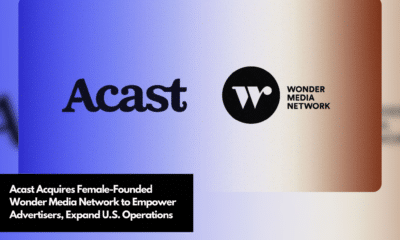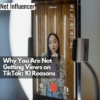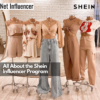Agency
Whalar Group Presents Foam, An Operating System For Streamlining Talent Management In The Creator Economy

The Creator management industry has reached a turning point: professional talent managers now handle over 75% of brand partnerships for Creators, a dramatic increase from 15-20% in 2021. This shift highlighted a crucial gap in the market – while Creators and brands had numerous tools at their disposal, talent managers lacked a unified system to run their operations efficiently, according to Simon Moss, Chief Product Officer at Foam, a division of Whalar Group, developed as a solution to address this specific need.
“When we first started, our teams were ultimately facing incredibly fragmented workflows,” explains Simon. “A real lack of real-time, data-driven insights, spreadsheets, chasing down screenshots from talent. We could see immediately that no platform had been designed specifically for talent managers of Creators, particularly those Creators that are digital first.”
The scale of content management presents a significant challenge. “If you’re an individual talent manager and you represent, say, 20 talent, your objective is growing those businesses,” Simon elaborates. “Each of those 20 talent is probably active on at least three platforms. So now you’ve got 60 channels to oversee. On each of those, you might have three or four pieces of content going out daily from your talent. It’s tough to stay on top of that.”
Communication adds another layer of complexity. “In essence, the manager is handling the inbox of all of the talent; all of the data that comes to the managers is unstructured,” Simon notes. “One agency may lay out the RFP in one format; another may lay out the other. Then, they must go back and forth to understand exclusivity, budget rates, etc., which can be timely.”
Facilitating Operations Through Technology
Foam’s platform introduces several key features that address these operational challenges:
Comprehensive Content Management
The platform provides managers with a unified view of their talent’s content across platforms. “The manager can set up an account on the Foam platform and invite their talent to connect through a one-time authorization,” Simon says. “The manager can’t post on behalf of the talent, but once the talent is authenticated with the agency account, the manager has everything at their fingertips at all times.”
The platform’s semantic search capabilities offer invaluable insight. “For example, we found a Creator talent that had spoken about being in a car crash but had not written it in the captions,” Simon recalls. “Someone may not necessarily post about that experience within the caption. Brands often look for people in specific communities talking about certain topics, but you don’t get any of that information within the captions. You need to have the audio transcriptions. That’s exactly what we did with our real-time content feed.”
Smart Content Organization
Foam’s playlist feature has transformed how managers showcase talent to brands. “You can say, ‘Find everybody in Foam that has an engagement rate over 5% and has worked with X brands or spoken about certain topics,’ add them to a playlist and keep it there,” Simon explains. “There are tens of thousands of playlists in Foam that have been created already. It just exploded.”
The system continues to advance: “Next year, we’ll make them dynamic. You can create a playlist of coffee drinkers or whatever. As you add more talent, they automatically get dynamically created, and then notifications will go out to people who have subscribed to that playlist.”
Enhanced Professional Communication
The platform’s Chrome extension has elevated client communications. “We’ve had managers forward us responses from brands who have commented on the format of the email they’ve been sent because the widgets are all nicely formatted; everything’s consistent,” Simon shares. “It has enhanced the feel of professionalism in communication for talent managers.”
The tool also supports relationship management: “Managers get a notification if it’s a Creator’s birthday next week…They’re strategists and advocates, nurturing and managing human relationships. They’re normally the biggest fan of the Creator.”
Setting New Standards in Data Verification
Foam’s platform stands out through its certified integrations with major social platforms. “We were one of the first companies to get TikTok API access. We were also the first partner to get Instagram Creator access,” Simon reveals. “I think there’s a real opportunity for us to shine a light on what is real.”
This commitment to accuracy manifests in practical features to improve brand relationships. “Let’s say you’re a brand, and you’re chasing me because you need the screenshots of that thing I’m asking you to pay me for,” Simon explains. “I can get you a screenshot, but then in three days, it’s out of date. It’s better to send you a PDF with a link to the live content. Or better yet, I can send you a link that will keep updating in real time because that post you paid for may explode in three days.”
The verification system provides transparency through time-stamped data. “If you embed a widget from the Chrome extension about a talent into an email, it has a verified stamp on it with the time and date brands can see immediately,” Simon notes. “The industry is starving for data and trust. It’s becoming increasingly important, and I think that level of transparency is essential.”
This includes preserving temporary content: “We keep the stories that vanish,” says Simon. “Different Creators use stories in different ways. They like stories because they vanish. But for the manager, it’s beneficial for them to see that. We can show a retention curve over time on how a story performed through the different parts of pieces of the carousel.”
Business Model Innovation
Foam has adopted a freemium approach to market entry. “We considered having a paid model upfront in the early days,” Simon explains. “The problem with a paid model upfront is that it creates friction, and people don’t get to come in and just play. Trust has to be earned.”
This strategy mirrors successful tech platforms: “When we looked at many of the tools we’re using internally across the business, not Foam, but other products like Loom, for example. They all have freemium options,” says Simon. “Why would we charge for it? We’ve built the technology to onboard one more agency or one more manager. It doesn’t cost us incremental funds.”
The approach reflects strategic growth planning. “We’ve been building quietly. We’ve done no marketing. Everything has come from referrals,” Simon reveals. “We’re confident enough now in the scale, the breadth of the tools, the product’s stickiness, and how much everybody loves it to say. Why don’t we just give this to every talent manager? It doesn’t matter if they’re not top or located in Hollywood or New York. You can be a manager anywhere in the world and use it.”
Future Development Plans
The platform continues to expand its capabilities. “We’ve developed a product internally for brand safety and creative vetting,” Simon reveals. “Brands are more and more nervous about hiring a Creator and then suddenly finding out that they’ve posted about something that conflicts with their values.”
Simon envisions an AI-enhanced future for the platform: “We think in the future, managers will be talking to Foam using audio. I’d like them to be able to press a button and say, ‘Create a media pack for this Creator specifically designed for Starbucks. Highlight all the past content they’ve done around [coffee],’ and then it will build the media pack.”
“The manager role will continue to be more and more important in the future because there are more Creators,” Simon concludes. “As we’ve got to know more and more managers, they’re just the unsung heroes. For almost every successful Creator, someone is in the background helping them navigate the complexities, deal with all the admin work, and negotiate the contracts.”





















